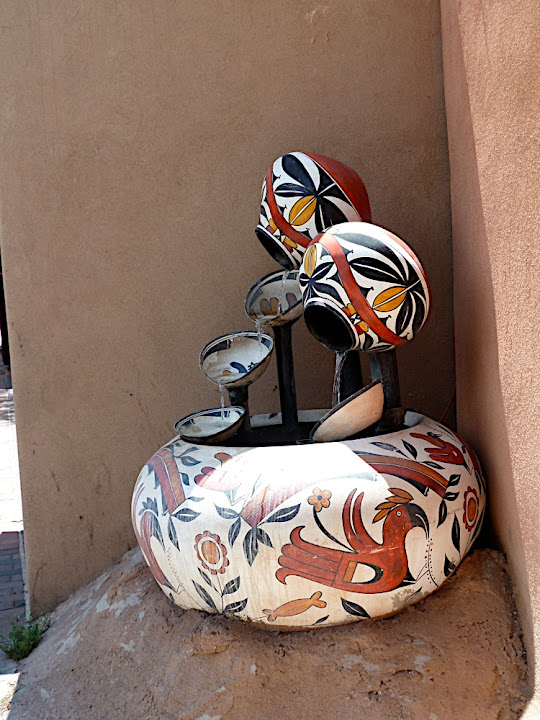pueblo
For a forward-facing society Americans are strangely preoccupied with roots. Not only do they qualify themselves by the country of origin of their ancestors (i.e. Irish-American or Italian-American) but also consider themselves spiritual descendants of (American) Indians. Case in point: Santa Fe. The city mandates the adobe style for all downtown buildings since 1958 and looks like an oversized pueblo. This must be ironic for Pueblo Indians, deprived of land and cultural expression for years in the name of civilization, to see their building style suddenly revered and imitated.
Indians return the favor when they shop at Home Depot for materials to repair and extend their ancestral pueblos: it’s much easier than to fashion doors from piñon wood or chip stone for walls. Not all Indians live in the old pueblos of course just like not all Santa Fe residents inhabit adobe houses.
.The Acoma Pueblo looks better from afar. Up close and personal you see the adobe being reinforced with modern bricks, colorful port-o-potties and beaten trucks parked along dirt covered streets. No electricity, running water or television though. There is an evident conflict between tradition and usability. If the pueblo is meant to reinforce tradition, vestiges of a modern world should be removed. Natives would probably attract more tourists, and more money, by creating a Disneyland-like model pueblo. On the other hand if they want to live in it, even if only a handful of their elders treat it as a year-round accommodation and others visit only for the ceremonies, why should it be kept intact? Aren’t they entitled to change their city anyway they want?
Santa Fe city planners caught on adobe fever in early 20th century when railroad bypassed the city and tourism was supposed to save the place from an unavoidable decline. They succeeded, but at a price. Buildings that did not fit the pattern disappeared. Dressing modern interiors in a pueblo-inspired outside earned the style a derogatory name of faux-dobe. And to boot, the lesson of the Indian building style was lost on white architects: it’s about function not esthetics. There is not much sense in retaining the mud color of external walls that is an incident of materials available to original pueblo builders. Important features are flat roofs with a low wall and multiple drains suitable for torrential rains (just imagine what happens to the foundation when 2 inches of rain per hour pour down a sloping roof all at once), thick walls, deep sunken small windows protecting from heat in the summer and cold in the winter. All those features could be recreated with modern materials to a much more interesting end result.
When everything from a luxury hotel to a Burger King restaurant looks pretty much the same the style gets boring rather quickly. But it’s not like Santa Fe is a bad place to spend couple of days. Especially if you like art in any shape or form. There are many really cool outdoor sculptures. Acoma pottery that we examine during the pueblo tour has geometrical patterns that look surprisingly modern, elegant and tasteful. Thankfully due to temporary lack of permanent residence we are quite immune to the appeal of both modern and Indian art pieces.
Sadly what passes for Indian art is everywhere: traded in the streets, by the roadside, in trendy boutiques and upscale galleries. Only small fraction is original and beautiful. Most comes from China either as materials (various substitutes of American turquoise: from genuine gems mined in China to imitation stones to aqua colored plastic) or finished products. But as long as sellers look like genuine American Indians tourists will buy it. It’s the perception that sells after all. Interestingly objects sold in pueblos are more expensive then the same items in Albuquerque or Santa Fe shops - a subtle but sure way to limit the number of people trespassing on sacred Indian grounds.
I cannot resist thinking that the area would be even more vibrant and interesting if pueblos stayed away from Home Depot and Santa Fe stayed away from pueblos. Imitation might be the most sincere form of flattery, but flattery rarely gets you where you want to be.

